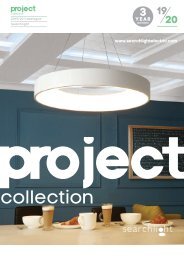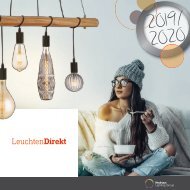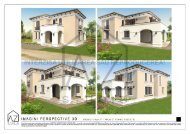CSG-Renewable_Topolog_RomaniaPDD_EN
You also want an ePaper? Increase the reach of your titles
YUMPU automatically turns print PDFs into web optimized ePapers that Google loves.
www.csgstandard.com<br />
www.zeroco2.cc<br />
<strong>Topolog</strong> Wind Power Project in Romania<br />
by E.K.W.Energy.S.R.L<br />
PROJECT DESIGN DOCUM<strong>EN</strong>T<br />
1
www.csgstandard.com<br />
www.zeroco2.cc<br />
CONT<strong>EN</strong>TS<br />
1. General description of the Project Activity<br />
2. Application of a baseline and monitoring methodology<br />
3. Duration of the Project Activity / crediting period<br />
4. Environmental impacts<br />
5. Stakeholders’ comments<br />
ANNEXES<br />
Annex 1: Contact information for participants in the Project Activity<br />
Annex 2: Baseline information<br />
Annex 3: Monitoring information<br />
Annex 4: Technical specifications of the installed units<br />
Annex 5: Legal statement<br />
2
www.csgstandard.com<br />
www.zeroco2.cc<br />
1. General description of the Project Activity<br />
1.1. Title of the Project Activity<br />
<strong>Topolog</strong> Wind Power Project in Romania by E.K.W.<strong>EN</strong>ERGY.S.R.L<br />
1.2. <strong>CSG</strong> Standard and selected methodology versions<br />
Type<br />
Version<br />
Standard <strong>CSG</strong> Standard version 1.0<br />
Methodology <strong>Renewable</strong> energy methodology version 1.0<br />
1.3. Description of the Project Activity<br />
<strong>Topolog</strong> Wind Power Project in Romania by E.K.W. <strong>EN</strong>ERGY.S.R.L (the Project Activity) is<br />
developed by E.K.W. <strong>EN</strong>ERGY.S.R.L (the Project Owner) and is located in Romania. The purpose of the<br />
Project Activity is to generate electricity through using wind resources.<br />
The Project Activity started in 2011. The electricity generated by the Project Activity is fed into<br />
the Romanian Electricity Grid (REG). The proposed project consisted of the installation of one wind<br />
turbine in Fagarasul Nou, Tolopog village, Tulcea County. The crediting period for this Project Activity<br />
starts in 2011.<br />
Romania has a great potential regarding wind power. Romania has about 23 TWh/y power<br />
generation potential using wind farms only 1 . At the end of the 2012 only 10% of the total potential<br />
have been reached. The best areas for this type of electricity are found in the provinces of Moldavia<br />
and Dobrogea. For this reason the Project Activity is located in Dobrogea.<br />
The wind power plant capacity is 600kW and the net annual electricity delivered to REG is 927<br />
MWh/y. According to the calculations of the <strong>CSG</strong>’s “<strong>Renewable</strong> Energy methodology” (see section<br />
1.2.) it will achieve a reduction in greenhouse gas emissions of approximately 594 tCO 2 per year (See<br />
table 2).<br />
Technical information<br />
Wind is a form of solar energy and is a result of the uneven heating of the atmosphere by the<br />
sun, the irregularities of the Earth’s surface, and the rotation of the Earth.<br />
The term wind energy describes the process by which the wind is used to generate<br />
mechanical power or electricity. Wind turbines operate on a simple principle. Wind turbines convert<br />
the kinetic energy of the wind into mechanical power. In this case, a generator converts the<br />
1 EWEA (February 2014). "Wind in power: 2013 European statistics". European Wind Energy Association.<br />
Retrieved 2014-11-05.<br />
3
www.csgstandard.com<br />
www.zeroco2.cc<br />
mechanical power into electricity. Therefore the wind turns the blades, which spin a shaft, which<br />
connects to a generator and makes electricity.<br />
Wind turbines can be used to produce electricity for a single home or building, but in the<br />
case of the Project Activity the wind turbine is connected to the Romanian National Grid (REG), and<br />
the generated power is used for a more widespread electricity distribution.<br />
The Project Activity is based on only one wind turbine, which is producing electricity since<br />
2011. The wind turbine has a 61.5 m height from the ground. The land where the project it’s located<br />
is owned by EKW <strong>EN</strong>ERGY.S.R.L.<br />
Baseline scenario<br />
The scenario existing prior to starting the implementation of the Project Activity is that the<br />
electricity is supplied by the REG where power generation is dominated by fossil fuel power plants.<br />
The project scenario is the activity of one wind turbine. The Project Activity started in 2011<br />
and in the first year it supplied more than 800 MWh to the REG. During the first 4 years of the<br />
activity the project fed 3709 MWh into REG and replace the same amount of electricity generated by<br />
power plants connected to the REG.<br />
The baseline scenario identified in Section 2.4 is the same as the scenario existing prior to<br />
starting the implementation of the Project Activity. Namely, the equivalent amount of electricity<br />
would have been supplied to the REG by grid-connected power plants in the absence of the Project<br />
Activity.<br />
The Project Activity generates electricity by utilizing renewable resources. The electricity with<br />
zero emission from the Project Activity is delivered to the REG to replace an equivalent amount of<br />
electricity that would have been generated by the REG where it is dominated by fossil fuel power<br />
plants (as shown in Table 12). Thus, the Project Activity will reduce greenhouse gas emissions versus<br />
the baseline scenario where the greenhouse gas emission sources are described in Section 2.<br />
The net annual electricity delivered to the REG is estimated to be about 927 MWh per year.<br />
Accordingly, it will achieve an average reduction in greenhouse gas emissions of 594 tCO 2 e per year<br />
during the crediting period (see Section 2).<br />
Details on the specifics of the installed systems can be found in Annex 4.<br />
Sustainable Development<br />
The Project Activity will supply clean energy through utilizing renewable energy resources. The<br />
implementation of the Project Activity will contribute to improving the environment while<br />
4
www.csgstandard.com<br />
www.zeroco2.cc<br />
developing the local economy. The proposed Project Activity will contribute to sustainable<br />
development in the following ways:<br />
<br />
<br />
<br />
<br />
<br />
<br />
Reduce the exploitation of fossil fuels by supplying renewable energy to improve the existing<br />
energy consumption model which relies on fossil fuels; also, it will improve energy security;<br />
Reduce the emissions of pollutants associated with the operation of fossil fuel thermal power<br />
plants, including SO 2 , NO x and dust in the baseline/business-as-usual scenario, thus<br />
improving the local environment;<br />
Reduce GHG emissions compared to the baseline/business-as-usual scenario;<br />
Facilitate the commercialisation of grid-connected solar power technologies and markets;<br />
Promote local economic development by creating local employment opportunities;<br />
It contributes to reaching the Romanian target for energy production from renewable<br />
sources.<br />
With the development of the proposed Project Activity, there will be a real and measurable<br />
contribution to the sustainable development of Romania in the following aspects:<br />
<br />
The Project Activity is in compliance with all national and local environmental initiatives:<br />
o<br />
o<br />
o<br />
o<br />
The project activity supports the objectives from Local Agenda 21 –sustainable<br />
development plan of Tulcea County. (Plan’s object: gaining new investments for the<br />
exploring the renewable energy sources);<br />
The Project Activity is in compliance with all quality requirements established in the<br />
Law 23/2014 for approving OUG 57/2013 concerning changing and completing the<br />
Law no 220/2008 for establishing the promotion of the system for producing energy<br />
from renewable energy resources.;<br />
The proposed Project Activity will produce renewable energy at a production price<br />
that is independent from worldwide market fluctuations and risks of fossil fuels;<br />
Having an operative, affordable, reliable and financially stable national energy<br />
production matrix is essential for any economic development in any country. Based<br />
on a reliable national energy generation matrix, stable supply and affordable energy<br />
prices, companies can feel more confident and secure with regards to their<br />
investments, especially in the production or energy-intensive sectors.<br />
5
www.csgstandard.com<br />
www.zeroco2.cc<br />
<br />
Job creation:<br />
o<br />
During the Project Activity, around 4 jobs were created, that were related to the<br />
security system and the maintenance procedures. During the implementation of the<br />
project, were created around 20 temporary jobs that were related to the design of<br />
the project and the arrangement and construction works (workers in charge with the<br />
technical execution, site master, technical designer, concrete workers, weld workers,<br />
technical climbers, drivers and other workers).<br />
If the Project Activity would be expanded during the crediting period, then is<br />
expected to create more jobs.<br />
Environmental impact:<br />
o<br />
o<br />
o<br />
o<br />
o<br />
All electricity generated by the proposed Project Activity is delivered to the national<br />
electricity grid and will replace electricity that has some GHG emissions associated<br />
with it, to be proven by the emission factor calculations later on. Basically, the<br />
Project Activity consists of a wind turbine that captures the energy of moving air and<br />
convert it to electricity. No by-products are produced during the operation of the<br />
Project Activity;<br />
Harnessing power from the wind is a clean and sustainable way to generate<br />
electricity as it produces no toxic pollution or global warming emissions. Wind is also<br />
abundant, and inexhaustible;<br />
The Project Activity requires essentially no water to operate and thus do not pollute<br />
water resources or strain supply by competing with agriculture, drinking water<br />
systems, or other important water needs;<br />
The environmental impact, compared to fossil fuels plants that produce the same<br />
amount of electric energy, is negligible;<br />
Generating electricity from renewable resources rather than fossil fuels offers<br />
significant public health benefits and it reduces overall healthcare costs.<br />
1.4. Project participants<br />
The project is developed by as the principle project owner.<br />
Table 1. Project participants<br />
Country<br />
Romania<br />
United Kingdom<br />
Private and/or public entity project participants<br />
E.K.W.Energy.S.R.L<br />
Carbon Solutions Global Ltd.<br />
6
www.csgstandard.com<br />
www.zeroco2.cc<br />
See Annex 1 for more details.<br />
1.5. Technical description of the Project Activity<br />
1.5.1. Location of the Project Activity<br />
Romania<br />
Country(ies) 2<br />
Region / State / Province<br />
Faragasul Nou Village, <strong>Topolog</strong> District<br />
City / Town / Community<br />
Tulcea County<br />
Details of physical location, including information allowing the unique identification of<br />
this Project Activity<br />
The proposed Project Activity takes place in only one location: Faragasul Nou Village, <strong>Topolog</strong><br />
District, Tulcea County. This location is placed in province of Dobrogea.<br />
*Coordinates: Latitude: 44° 85' 8.226", Longitude: 28° 27' 5.375"<br />
1.5.2. Category(ies) of Project Activity 3<br />
The Project Activity falls into:<br />
Scope 1<br />
<br />
<br />
Sectorial scope: Energy industries (renewable/non-renewable sources)<br />
Project Activity: <strong>Renewable</strong> power generation<br />
2<br />
3<br />
“Host Party(ies)” in original CDM PDD template<br />
https://cdm.unfccc.int/DOE/scopelst.pdf<br />
7
www.csgstandard.com<br />
www.zeroco2.cc<br />
1.5.3. Technology to be employed in the Project Activity<br />
Scenario existing prior to the Project Activity<br />
According to the National Regulatory Authority for Energy in 2012, fossil fuels represented<br />
53% of the Romanian energy consumption mix used for electricity generation, followed by nuclear<br />
(20%), hydroelectric (23%) and other renewables (4%).<br />
Energy supply existing prior to starting the implementation of the Project Activity is provided<br />
by the REG, which is dominated by fossil fuels power plants. Obviously, it is not likely that such an<br />
electricity supply model will change significantly in the short term. In the absence of the Project<br />
Activity, the electricity generated by the Project Activity would have been provided by the REG<br />
though either expanding the existing capacity of fossil fuel thermal power plants or installing new<br />
fossil fuel thermal power generation units. Thus, the baseline scenario is the same as the scenario<br />
existing prior to starting the implementation of the Project Activity, namely, the equivalent amount<br />
of electricity is provided by power plants connected to the REG.<br />
Project scenario<br />
The purpose of the proposed project is to generate zero-emission electricity and fed into<br />
REG. The project scenario is the installation and operation of one wind turbine, which will supply an<br />
average annual 927 MWh/year to the REG and replace the same amount of electricity generated by<br />
power plants connected to the REG.<br />
1.5.4. Estimated amount of emission reductions over the chosen crediting period<br />
Expected annual emission reductions are as follows:<br />
Table2. Estimated annual emission reductions<br />
Years<br />
Annual estimation of emission reductions in<br />
tonnes of CO 2 e<br />
2011 516<br />
2012 619<br />
2013 714.5<br />
2014 526.4<br />
2015 594<br />
2016 594<br />
2017 594<br />
2018 594<br />
2019 594<br />
2020 594<br />
8
www.csgstandard.com<br />
www.zeroco2.cc<br />
Total estimated emission reductions (in tonnes 5939.9<br />
of CO2e)<br />
Total number of crediting years 10<br />
1.5.5. Public funding of the Project Activity<br />
No public funding is considered for the Project Activity.<br />
2. Application of a baseline and monitoring methodology<br />
2.1. Title and reference of the approved baseline methodology applied to the Project<br />
Activity<br />
The emission reductions are calculated based on <strong>CSG</strong> Standard’s “Solar, wind and hydro-power<br />
energy-based grid-attachable electricity production methodology” Based on the above-mentioned<br />
methodology, the following details have been calculated:<br />
<br />
<br />
<br />
Initial emission reductions;<br />
Emission factor;<br />
Estimated annual emission reduction.<br />
2.2. Justification for choosing the methodology and why it is applicable to the Project<br />
Activity<br />
The “<strong>Renewable</strong> Energy methodology” is applicable to the proposed Project Activity, since all<br />
power generation units will be connected to the electric power grid where there was no wind gridattachable<br />
electricity production unit before the realization of the project.<br />
Also the methodology doesn’t have special criteria regarding the project’s size, therefore it is<br />
applicable also to small projects. This project is based on a single wind turbine operation, therefore<br />
the “Solar, wind and hydro-power energy-based grid-attachable electricity production methodology<br />
(<strong>Renewable</strong> Energy methodology)” is the best way to promote and develop small project that can<br />
have local and national impact.<br />
Table 3. Methodology criteria and applicability<br />
Criteria Applicability Conclusion<br />
The methodology is applicable in the case The proposed Project Activity generates OK<br />
of renewable energy-based power plants electricity through utilizing wind<br />
resources.<br />
Power plants shall be connected to the<br />
power grid<br />
Units are connected to the REG.<br />
OK<br />
The methodology is applicable to the<br />
following project types:<br />
building a new power plant (where<br />
there was no grid-attachable<br />
electricity production unit before<br />
the realization of the project);<br />
The proposed Project Activity will take<br />
place only in locations where there was<br />
no wind grid-attachable electricity<br />
production unit before the realization of<br />
the project.<br />
OK<br />
9
www.csgstandard.com<br />
www.zeroco2.cc<br />
<br />
<br />
<br />
expanding a power plant or power<br />
stations, or increasing<br />
performance;<br />
reconstruction of existing power<br />
plants;<br />
An existing project with less than<br />
five years of activity.<br />
2.3. Description of how the sources and gases are included in the project boundary<br />
The following table shows which source of emissions and gases are included in the project<br />
boundary for the purpose of calculations project emissions and baseline emissions:<br />
Table 4. Sources of emissions<br />
Source Gas Included?<br />
Emissions from electricity generation in fossil fuel power plants that CO 2<br />
Yes<br />
are displaced thanks to the Project Activity.<br />
CH 4<br />
No<br />
N 2 O<br />
No<br />
For geothermal power plants, fugitive emissions of CH 4 and CO 2 from CO 2<br />
No<br />
non-condensable gases contained in geothermal steams.<br />
CH 4<br />
No<br />
N 2 O<br />
No<br />
CO 2 emissions from the combustion of fossil fuels for electricity CO 2<br />
No<br />
generation in wind power plant and geothermal power plants. CH 4<br />
No<br />
N 2 O<br />
No<br />
For hydro-power plants, emissions of CH 4 from the reservoir. CO 2 No<br />
CH 4<br />
No<br />
N 2 O<br />
No<br />
2.4. Description of how the baseline scenario is identified and description of the<br />
identified baseline scenario<br />
Baseline emissions include only CO 2 emissions from electricity generation in fossil fuel power<br />
plants and plants that use renewable resources, which are displaced thanks to the Project Activity.<br />
Thus, the implementation of the Project Activity contributes to the decreasing greenhouse gas<br />
emissions in the electricity mix of Romania, due to its activity that will displace some of the thermal<br />
energy sources of the national grid.<br />
10
www.csgstandard.com<br />
www.zeroco2.cc<br />
2.5. Description of how the anthropogenic emissions of GHG by sources are reduced<br />
below those that would have occurred in the absence of the registered CDM<br />
Project Activity (assessment and demonstration of additionality)<br />
According to <strong>CSG</strong> Standard version 2.1, from the three additional requirements (legal,<br />
environmental and financial) at least two shall be met by every <strong>CSG</strong> project. The proposed Project<br />
Activity met the criteria of legal and environmental requirement as demonstrated below. (See table<br />
5) *financial requirement was not assessed.<br />
Table 5. Additionality criteria<br />
Additionality criteria<br />
Legal<br />
Financial<br />
Environmental<br />
Conclusion<br />
OK<br />
Not applicable<br />
OK<br />
LEGAL ADDITIONALITY<br />
The proposed Project Activity is not realized with the purpose of fulfilling legal obligations or<br />
industrial standards that Project Participants are subject to.<br />
Romania’s strategic priorities in the energy sector are incorporated into the Act on Electrical<br />
Energy Law 127/2014. This law governs the energy market in Romania and provides the legal basis of<br />
operation for distribution companies. Also, Law 23/2014 for approving OUG 57/2013 concerning<br />
changing and completing the Law no 220/2008 for establishing the promotion of the system for<br />
producing energy from renewable energy resources, provides the necessary legal framework for all<br />
renewable energy generation and distribution activities in the country.<br />
The proposed Project Activity is in compliance with all the dispositions of this law.<br />
FINANCIAL ADDITIONALITY<br />
Not applicable.<br />
<strong>EN</strong>VIRONM<strong>EN</strong>TAL ADDITIONALITY<br />
Electricity delivered to the grid by the Project Activity would have otherwise been generated<br />
by the operation of grid-connected power plants. The methodology states that total emission<br />
reductions will be the difference between baseline emissions and project emissions. As mentioned<br />
before, a wind power plant project has no emissions to be calculated, so total emission reductions<br />
will be the baseline emissions.<br />
11
www.csgstandard.com<br />
www.zeroco2.cc<br />
SUPPORTED <strong>EN</strong>VIRONM<strong>EN</strong>TAL ACTIVITIES<br />
<strong>CSG</strong> Standard version 1.0 requires that “In the event that a project does not meet the<br />
requirement of financial additionality, the project developer must use at least 70 percent of the<br />
proceeds from the sale of credits to finance environmental protection activities. Environmental<br />
protection activities are those with the aim to preserve or restore environmental media (i.e. air,<br />
groundwater, surface water, soil and biota) through preventing the emission of pollutants or<br />
reducing the presence of polluting substances in the environment.”<br />
70% of the income generated by the proposed Project Activity will support the following activities:<br />
<br />
<br />
<br />
raise awareness of climate change through promoting wind turbine and the renewable<br />
resources;<br />
support community and municipal energy efficiency programmes;<br />
Reforestation of the area affected by climate change in Romania.<br />
2.6. Emission reductions<br />
2.6.1. Explanation of methodological choices<br />
According to the <strong>CSG</strong> Standard’s “Solar, wind and hydro-power energy-based grid-attachable<br />
electricity production methodology” version 2.1, the following procedure shall be used:<br />
Physical boundaries<br />
Since the project contains only renewable energy-based power plants and all power plants<br />
are connected to the public grid, the electricity system of the whole country should form the basis of<br />
calculating the emission factor.<br />
Calculating baseline emission reductions<br />
Baseline emission reduction is the amount of carbon-dioxide that will not get into the<br />
atmosphere on a yearly basis due to the utilization of the newly built power plant. Its unit is t CO 2 /y.<br />
Annual emission reductions can be calculated by multiplying the electrical power generated by the<br />
solar panel system in kWh by the emission factor of the electrical grid. The calculation is made<br />
according to Equation 1:<br />
where:<br />
BE = EG * EF CO2<br />
Equation 1<br />
<br />
<br />
BE: baseline yearly CO 2 savings [tCO 2 e/y];<br />
EG: energy produced by a renewable energy-based power plant [MWh/y]; and<br />
12
www.csgstandard.com<br />
www.zeroco2.cc<br />
<br />
EF CO2 : network emission factor [tCO 2 e/MWh].<br />
Determining the emission factor<br />
The electrical power produced from renewable energy sources will reduce production in fossil<br />
power plants, since these power plants are the ones that are adjusted to load demands on the<br />
electrical power grid. It is because the electricity generated from renewable energy sources does not<br />
affect:<br />
<br />
<br />
The production of nuclear power plants, because these power plants are always operated at<br />
the maximum capacity allowed by technical facilities, therefore they are never adjusted to<br />
load demands on an electrical power grid;<br />
Small power plant production, since most of these are subject to mandatory takeover, thus<br />
they do not participate in the load distribution of the system. For purposes of emission factor<br />
calculation, it is important to use the most up-to-date data from the current year, or if not<br />
available then from the previous year. Data older than one year can’t be used for calculation.<br />
Electricity import is not covered, since it would make the monitoring procedures much<br />
more complicated, without significantly improving the accuracy of the calculation.<br />
The calculation of the emission factor is based on Equation 2 of the methodology:<br />
Equation 2<br />
Where:<br />
EF CO2 : network emission factor [tCO 2 e/MWh];<br />
FC i;m : “i” type fuel quantity used by “m” power plant for the given year *m 3 /y or kg/y];<br />
NCV i : calorific value of “i” type fuel *MJ/m 3 or MJ/kg];<br />
EF i : emission factor of “i” type fuel *tCO 2 e/MJ].<br />
EG m : electrical power fed into the grid by “m” fossil-fuel power plant [MWh/y]<br />
13
www.csgstandard.com<br />
www.zeroco2.cc<br />
The 0.8 multiplier is necessary because the whole fuel consumption and thus part of its<br />
carbon emissions is turned into the production of heat generated by power plants. The emission<br />
associated with the production of this heat is 20%, according to the most recent data (from 2012).<br />
The Romanian Energy Regulatory Authority (ANRE) does not report the fuel type and<br />
quantity used by specific power plants, only the total energetic value of the different fuels used in<br />
the whole electricity sector in a given year. Thus Equation 2 reduces to:<br />
Where<br />
Equation 3<br />
FCE i : total energy value of “i” type of energy resource used in the national electricity generation<br />
industry for the given year [TJ/y];<br />
EGF i : electrical power fed into the grid by using “i” type fossil fuel for the given year [MWh/y].<br />
Emission reductions<br />
According to the <strong>CSG</strong> Standard’s “Solar, wind and hydro-power energy-based grid-attachable<br />
electricity production methodology” version 2.1, the following formula shall be used to calculate<br />
emission reductions thanks to the Project Activity:<br />
Where:<br />
ER: annual emission reductions; [tCO 2 e/y];<br />
BE: baseline emissions [tCO 2 e/y];<br />
ER = BE - PE<br />
Equation 4<br />
PE: GHG emissions from fossil fuel consumption [tCO 2 e/y].<br />
2.6.2. Data and parameters that are available at the validation stage<br />
Table 6. EGF i<br />
Data / Parameter:<br />
EGF i<br />
Data unit:<br />
MWh/y<br />
Description:<br />
Annual net energy delivered to the Romanian<br />
Electricity Grid by using “i” type fossil fuel<br />
Source of data used:<br />
Romanian Energy Regulatory Authority (ANRE)<br />
Value applied: Details in Annex 2<br />
14
www.csgstandard.com<br />
www.zeroco2.cc<br />
Justification for choosing source of data or<br />
description of measurement methods and<br />
procedures actually applied:<br />
Any comment:<br />
The information is official and publicly available<br />
Official data<br />
Table 7. FCE i<br />
Data / Parameter:<br />
FCE i<br />
Data unit:<br />
TJ/y<br />
Description:<br />
Total energy value of “i” type of energy resource<br />
used in the Romanian electricity generation<br />
industry for the given year<br />
Source of data used:<br />
Romanian Energy Regulatory Authority (ANRE)<br />
Value applied: Details in Annex 2<br />
Justification for choosing source of data or The information is official and publicly available<br />
description of measurement methods and<br />
procedures actually applied:<br />
Any comment:<br />
Official data<br />
Table 8. EF i<br />
Data / Parameter:<br />
EF i<br />
Data unit:<br />
tCO 2 e/TJ<br />
Description:<br />
Emission factor of “i” type fuel<br />
Source of data used:<br />
The Romanian National Institute of Statistics<br />
Value applied: Details in Annex 2<br />
Justification for choosing source of data or The information is official and publicly available<br />
description of measurement methods and<br />
procedures actually applied:<br />
Any comment:<br />
Official data<br />
2.6.3. Ex-ante calculation of emission reductions<br />
Emission factor<br />
The emission factor (EF CO2 ) for the proposed Project Activity is calculated as the formula (3):<br />
EF CO2 = 0.640tCO 2 e/kWh<br />
Baseline emissions<br />
Baseline emission (BE) for the proposed Project Activity is calculated as the formula (1):<br />
BE 2011 = 0.640 × 805.6 = 516.3 tCO 2 e/y;<br />
BE 2012 = 0.640 × 966.5 = 619.4 tCO 2 e/y;<br />
BE 2013 = 0.640 × 1114.8 = 714.5 tCO 2 e/y;<br />
BE 2014 = 0.640 × 821.2 = 526.4 tCO 2 e/y;<br />
15
www.csgstandard.com<br />
www.zeroco2.cc<br />
Average baseline emissions is calculated based on existing data for the first 4 years of the crediting<br />
period (the quantity of energy produced by the wind turbine and delivered to REG):<br />
BE average (2011-2020) = 0.640 × 927=594.2 tCO 2 e/y.<br />
Project emissions<br />
Since no fossil fuel is consumed during the operation of the wind power plant, project emission (PE)<br />
is zero:<br />
PE = 0.<br />
Emission reductions<br />
Emission Reductions (ER) for the proposed Project Activity is calculated as the equation (4):<br />
ER 2011 = 516.3 - 0 = 516.3 tCO 2 e/y;<br />
ER 2012 = 619.4 - 0 = 619.4 tCO 2 e/y;<br />
ER 2013 = 714.5 - 0 = 714.5 tCO 2 e/y;<br />
ER 2014 = 526.4 - 0 = 526.4 tCO 2 e/y;<br />
ER average = 594.2- 0 = 594.2 tCO 2 e/y;<br />
2.7. Application of the monitoring methodology and description of the monitoring plan<br />
2.7.1. Data and parameters monitored<br />
Table 9. EG<br />
Data / Parameter<br />
Data unit:<br />
Description:<br />
Source of data used:<br />
Value of data applied for the purpose of<br />
calculating expected emission reductions in<br />
Section 1.4.4<br />
Justification for choosing source of data or<br />
description of measurement methods and<br />
procedures actually applied:<br />
Any comment:<br />
EG<br />
kWh/y<br />
Net electricity produced by the Project Activity<br />
delivered to the REG<br />
Measurement<br />
594.2<br />
Meter readings<br />
2.7.2. Description of the monitoring plan<br />
As established in the methodology, the only variable that needs to be verified and monitored<br />
during the crediting period is the total amount of electricity delivered to the electric grid, for the<br />
following period: 2015-2020. For this years the calculations of the emission factor are performed on<br />
an ex-ante basis, so it is necessary to update any other variable during the crediting period. For the<br />
16
www.csgstandard.com<br />
www.zeroco2.cc<br />
first 4 years of the crediting period, the emission factor is calculated based on the total amount of<br />
electricity already delivered to the REG (See table 11).<br />
Monitoring management structure<br />
The project owner shall designate the qualified staff member responsible for all relevant<br />
matters, including monitoring, data collection and archiving, quality assurance, and verification.<br />
The responsibilities of the staff member are briefly described as follows:<br />
<br />
<br />
<br />
Management: in charge of all relevant matters having to do with the monitoring activity.<br />
Monitoring: monitor, collect and archive data.<br />
Audit: execute quality control procedures.<br />
All relevant data will be monitored and electronically stored. An electronic spreadsheet file will<br />
be kept to accumulate all monitored variables and will be presented for verification.<br />
Any corrective monitoring/reporting actions that may be required throughout this process shall<br />
be communicated to the <strong>CSG</strong> Climate Department.<br />
Emission Reductions<br />
Emission reductions from the project will be counted as the total electricity delivered to the<br />
grid, multiplied by the emission factor of the REG. These data will be directly used for the calculation<br />
of emission reduction.<br />
In order to monitor the total emission reductions, a simplified calculation model will be<br />
used. (see Annex 4 for details).<br />
Electricity generation:<br />
Meters and metering<br />
Project electricity generation from the wind power plant will be monitored through the use of<br />
onsite metering equipment at the substation (interconnection facility connecting the facility to the<br />
grid).<br />
The meters will have to record on memory the accumulated kilowatt-hours. The meters will be<br />
read.<br />
<br />
Calibration of meters<br />
The meters will be checked and calibrated by a qualified third party, in compliance with the<br />
requirements of national standards and relevant sectorial regulations.<br />
17
www.csgstandard.com<br />
www.zeroco2.cc<br />
Data management<br />
Real-time measurements of the internal meter are transferred via the Internet to a dedicated<br />
data server (see specification in Annex 4) that can be accessed by the technical operator remotely.<br />
Copies of the sales receipts issued by the electricity service provider will be stored electronically as<br />
well.<br />
Quality Control<br />
All relevant data will be recorded and stored in a secure and mirrored database to prevent<br />
data loss or unauthorized access. Additionally, a final cross-check of the data will be carried out using<br />
sales receipts. Also, every unit will have a direct monitoring system to detect any kind of failure in the<br />
electric system. All data monitored and required for verification and issuance of VERs will be stored<br />
for five years after the end of the last crediting period or the last issuance of VERs, whichever occurs<br />
later. The following monitoring procedure has been developed in order to generate the necessary<br />
information for verification purposes:<br />
18
www.csgstandard.com<br />
www.zeroco2.cc<br />
3. Duration of the Project Activity / crediting period<br />
3.1. Duration of the Project Activity<br />
1.1.1. Starting date of the Project Activity<br />
The project starting date is determined by the date of signature on the purchase agreement<br />
for the key equipment: 2011<br />
1.1.2. Expected operational lifetime of the Project Activity<br />
The project is expected to have an operational lifetime of 25 years.<br />
1.2. Determining the crediting period and related information<br />
1.2.1. <strong>Renewable</strong> crediting period<br />
Starting date of the first crediting period:<br />
Not applicable.<br />
Length of the first crediting period:<br />
Not applicable.<br />
1.2.2. Fixed crediting period<br />
Starting date:<br />
1.01.2011<br />
Length:<br />
10 years<br />
2. Environmental impacts<br />
2.1. Documentation on the analysis of the environmental impacts, including<br />
transboundary impacts<br />
According to CGS Standard v.1.2:<br />
“By selecting sustainability indicators, the project’s expected contribution to sustainable<br />
development during its life span can be monitored continuously. These sustainability indexes vary<br />
with each project, because they are based on the description of social and environmental impacts<br />
and/or benchmark (using baseline values as referential points) analysis. Project developers are<br />
required to make a report in writing on how they continuously measure and monitor selected<br />
sustainability indexes. One way of doing it is to submit an annual report and other documents,<br />
according to the phase of emission reductions the project is in at the moment.”<br />
19
www.csgstandard.com<br />
www.zeroco2.cc<br />
Climate change<br />
The Project Activity leads to significant GHG emission reductions as described above and thus<br />
contributes to sustainable development in Romania, and reduces the energy dependency of the<br />
country. The transport and installation of the wind turbine may contribute to GHG emissions, but this<br />
effect is by far outweighed by the emission reductions resulting from the Project Activity.<br />
Compared with other low carbon power sources, wind turbines have some of the lowest<br />
global warning potential per unit of electrical energy generated.<br />
Air pollution<br />
No significant air pollution is caused by the Project Activity. Wind power consumes no fuel<br />
and no water for continuing operation and has no emissions directly related to electricity production.<br />
Wind turbines produce no carbon dioxide, carbon monoxide, sulphur dioxide, mercury,<br />
radioactive waste, or any other type of air pollution. In the installation phase, minor dust emissions<br />
were possible, although this is not considered significant since it didn’t exceeded or even came close<br />
to legal limits.<br />
Up- and downstream processes may contribute to air pollution during transport, material<br />
extraction, waste collection and handling, etc., although its magnitude is difficult to estimate and due<br />
to the lack of control over the above-mentioned processes, the Project Activity cannot be responsible<br />
for such impacts.<br />
Noise<br />
In the construction phase, a slight noise is possible, although this is not considered significant<br />
since it does not exceed the legal limits set out in local or national regulations.<br />
Under normal operating conditions, most of the sound generated by the wind turbine is<br />
aerodynamic, caused by the movement of turbine blades through the air. There is also mechanical<br />
sound generated by the turbine itself. Overall sound levels depend on the wind speed. But given the<br />
fact that this project has only one turbine, the noise level will be low, almost imperceptible. The<br />
impact on the communities in the neighborhood of the project will be small.<br />
Waste generation<br />
During the installation and operation of the wind power plant, neither significant quantities<br />
of municipal solid waste, nor hazardous waste are generated.<br />
At the end-of-life stage, the electronic equipment will produce a significant amount of<br />
hazardous waste and will be subject to the WEEE (Waste Electrical and Electronic Equipment)<br />
regulation and shall be treated separately in dedicated waste recovery and disposal facilities. Since it<br />
20
www.csgstandard.com<br />
www.zeroco2.cc<br />
is expected to take place in 2040 or later, it is very difficult to assess the future environmental<br />
impacts from the waste generated.<br />
Land use<br />
Given the fact that this project has only one turbine, no significant land use and subsequent<br />
impact on the natural ecosystem or agricultural activity is expected.<br />
Water use<br />
There is no water impact associated with the Project Activity. As in all manufacturing<br />
processes, some water is used to manufacture steel and cement for wind turbines, but the Project<br />
Activity cannot be responsible for such impacts.<br />
Visual impact<br />
Due to their height wind turbines are highly visible structures in any landscape. In some cases<br />
the visual impact of the landscape may be ruined, if are too many turbines, but in case of this Project<br />
Activity, one larger wind turbine is more acceptable than a number of small ones. Therefore, in this<br />
case, being visible is not necessarily the same as being intrusive.<br />
Wildlife and habit<br />
The impact of wind turbines on wildlife is most notably on birds and bats. If the project will<br />
have a negative impact on the wild life and if the bats and birds habitat will be affected, then<br />
measures for decreasing this impact will be taken.<br />
For example, wildlife biologists have found that bats are most active when wind speeds are<br />
low. Using this information, keeping the wind turbine motionless during times of low wind speeds<br />
could reduce bat deaths by more than half, without significantly affecting power production.<br />
Life-Cycle Global Warming Emissions<br />
There are no global warming emissions associated with operating wind turbines.<br />
Nevertheless, there are emissions associated with other stages of a wind turbine’s life-cycle,<br />
including materials production, operation and maintenance and decommissioning and<br />
dismantlement, but the Project Activity cannot be responsible for such impacts.<br />
21
www.csgstandard.com<br />
www.zeroco2.cc<br />
Conclusion<br />
Wind powered power generation units not only use renewable energy sources, but they are<br />
also characterized by an almost complete lack of negative environmental consequences, especially if<br />
compared to traditional fossil fuel power plants.<br />
The Project Activity does not entail serious negative environmental impacts. Although in two<br />
impact categories, climate change, solid waste and land use, slightly negative transboundary impacts<br />
are expected at the up- and downstream stages of the production system, the environmental and<br />
social advantages significantly outweigh the negative consequences. Also in the wildlife and habit<br />
impact category is expected a slightly negative impact.<br />
Table 10. Summary of estimated environmental impacts (++: significantly positive, + slightly<br />
positive, 0: insignificant/not applicable, - slightly negative, -- significantly negative)<br />
Environmental impact category Construction<br />
phase<br />
Operation<br />
phase<br />
Transboundary<br />
(life-cycle) processes<br />
Climate change 0 ++ -<br />
Solid waste 0 + -<br />
Waste water 0 0 0<br />
Photochemical smog formation 0 + 0<br />
Noise 0 0 -<br />
Visual impact 0 0 -<br />
Land use 0 0 -<br />
Water use 0 0 -<br />
Wildlife and habit 0 - -<br />
2.2. If environmental impacts are considered significant by the project participants or<br />
authorities, please provide conclusions and all references to support<br />
documentation of an environmental impact assessment undertaken in accordance<br />
with the procedures as required by the law<br />
Not applicable.<br />
3. Stakeholders’ comments<br />
3.1. Brief description how comments by local stakeholders have been invited and<br />
compiled<br />
Not applicable.<br />
3.2. Summary of the comments received<br />
Not applicable.<br />
22
www.csgstandard.com<br />
www.zeroco2.cc<br />
3.3. Report on how due account was taken of any comments received<br />
Not applicable.<br />
23
www.csgstandard.com<br />
www.zeroco2.cc<br />
Annex 1: Contact information for participants in the Project Activity<br />
Project participants<br />
E.K.W. <strong>EN</strong>ERGY.S.R.L Name Florescu Dan Adrian<br />
Post of employment<br />
Office address<br />
Phone<br />
E-mail<br />
Carbon Solutions Global Ltd. Name Peter Gaspar<br />
Post<br />
CEO<br />
Office address 1095 Budapest, Soroksári u. 48, HUNGARY<br />
Phone<br />
E-mail<br />
Annex 2: Baseline information<br />
Table 11. Total energy produced by the Project Activity: wind power plant (MWh/y)<br />
Year<br />
Total energy produced by the Project Activity: wind power plant (MWh/y)<br />
2011 805.65<br />
2012 966.5<br />
2013 1114.8<br />
2014 821.2<br />
Table 12. Total energy value of “i” type of energy resources used in the Romanian electricity<br />
generation industry in 2013<br />
Fuel type<br />
Total energy value of “i” type of energy resources used in the Romanian<br />
electricity generation industry in 2012 (TJ/y)<br />
Coal 206209.75<br />
Natural gas 62595.65<br />
Oil 3642.69<br />
Table 13. Emission factor of “i” type fuel<br />
Fuel type<br />
Emission factor of “i” type fuel (tCO 2 /TJ)<br />
Coal 89.04<br />
Natural gas 55.43<br />
Oil 79.71<br />
24
www.csgstandard.com<br />
www.zeroco2.cc<br />
Table 14. Annual net energy delivered to the Romanian Electricity Grid by using “i” fossil fuel in<br />
2012<br />
Fuel type<br />
Annual net energy delivered to the Romanian Electricity Grid by using “i”<br />
fossil fuel in 2010 (MWh/y)<br />
Coal 22926000<br />
Natural gas 8698000<br />
Oil 427000<br />
Annex 3: Monitoring report template<br />
Click here to add text.<br />
Annex 4: Technical specifications of the installed units<br />
Click here to add text.<br />
25

















